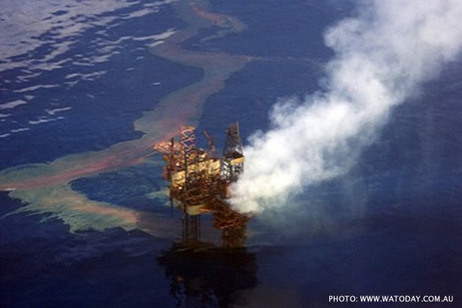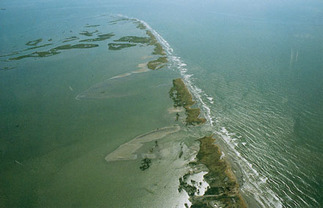How Much Do Sand Berms Cost?

The Deepwater Horizon rig on fire.
Information on the overall cost of the Louisiana sand berm project is very difficult to find because there is no clear timeline as to when funds were promised, disbursed, and what funds are remaining. The overall cost of the sand berm project may never be known because of intangible costs which are extremely difficult to estimate; for instance, the ecological cost of building the berms or the opportunity cost of what the funds could have been spent on that could have had a more beneficial impact on the environment.
Below is a basic timeline of announcements that relate to the cost of this project:
Partly motivated by talk over the true effectiveness of the sand berm projects, Governor Jindal announced November 1st that an agreement had been reached to commit $100 million of the $140 million that BP had pledged for coastal restoration projects (such as stabilizing the sand berms with wildlife, thereby creating barrier islands and rebuilding and further stabilizing some of the barrier islands off of Louisiana’s coast). The Governor’s press release also stated that Louisiana was working with NOAA to receive another $40 million in State and Federal “Coastal Wetlands Planning Protection and Restoration Act funds to restore barrier islands on the west side of the Mississippi River” (Office of the Governor: Louisiana)
Another issue with the current situation is that the funds provided by BP will not “go as far” as experts had originally predicted it would. New estimates (as of October 21, 2010) project that only 22 miles of sand berms will be able to be built, instead of 40 miles, mainly due to expanding where the berms will be placed so that they have less of an impact on coastal estuaries (New York Times).
Further complicating the situation of trying to determine how much damage has been prevented (or caused) by the sand berms is an extremely complicated, if all but impossible, project. The ecological impact alone cannot be estimated in terms of solid dollar amount. “Some conservation groups and scientists assert that the project has not only been ineffective but could also threaten wildlife. They warn that the intensive dredging associated with the berms has already killed at least a half-dozen endangered sea turtles and could kill many more” (New York Times).
On the positive side, the sand berm project has had a positive impact on the state economy in one sense because foreign funds (British funds from BP) are flowing into the state in order to replace some (but not nearly close to all of the damage caused by the spill) of the lost revenue in the area. However, many of the companies that have the necessary expertise in dredging and other specialized work that is required for these projects are usually headquartered out of state, though they do usually have a large presence in the state. Even if companies before the oil spill did not have a presence in the area, those people who have come to work in Louisiana to clean up the aftermath of the spill are based in Louisiana and by virtue of their presence (and hotel, food, recreational expenditures, et cetera) are helping the local economy and, by extension, the state economy (New York Times).
Below is a basic timeline of announcements that relate to the cost of this project:
- June 2, 2010: Announcement of a $360 million fund to protect Louisiana’s coastal areas – BP billed by Whiite House for cost
- As of November 1, 2010: BP pledges $140 million for sand berm and barrier island restoration; Still $140 million of $360 million left to be spent (unclear whether $140 million is from new BP pledge of $140 million or an actual disbursement of $360 million billed for earlier) (Office of the Governor: Louisiana)
Partly motivated by talk over the true effectiveness of the sand berm projects, Governor Jindal announced November 1st that an agreement had been reached to commit $100 million of the $140 million that BP had pledged for coastal restoration projects (such as stabilizing the sand berms with wildlife, thereby creating barrier islands and rebuilding and further stabilizing some of the barrier islands off of Louisiana’s coast). The Governor’s press release also stated that Louisiana was working with NOAA to receive another $40 million in State and Federal “Coastal Wetlands Planning Protection and Restoration Act funds to restore barrier islands on the west side of the Mississippi River” (Office of the Governor: Louisiana)
Another issue with the current situation is that the funds provided by BP will not “go as far” as experts had originally predicted it would. New estimates (as of October 21, 2010) project that only 22 miles of sand berms will be able to be built, instead of 40 miles, mainly due to expanding where the berms will be placed so that they have less of an impact on coastal estuaries (New York Times).
Further complicating the situation of trying to determine how much damage has been prevented (or caused) by the sand berms is an extremely complicated, if all but impossible, project. The ecological impact alone cannot be estimated in terms of solid dollar amount. “Some conservation groups and scientists assert that the project has not only been ineffective but could also threaten wildlife. They warn that the intensive dredging associated with the berms has already killed at least a half-dozen endangered sea turtles and could kill many more” (New York Times).
On the positive side, the sand berm project has had a positive impact on the state economy in one sense because foreign funds (British funds from BP) are flowing into the state in order to replace some (but not nearly close to all of the damage caused by the spill) of the lost revenue in the area. However, many of the companies that have the necessary expertise in dredging and other specialized work that is required for these projects are usually headquartered out of state, though they do usually have a large presence in the state. Even if companies before the oil spill did not have a presence in the area, those people who have come to work in Louisiana to clean up the aftermath of the spill are based in Louisiana and by virtue of their presence (and hotel, food, recreational expenditures, et cetera) are helping the local economy and, by extension, the state economy (New York Times).
Future Economic Benefits of the Sand Berms

Source: University of Vermont
There are some scientists who believe that the sand berms will prove to be a success in the future, even if they fail at their short-term goals of keeping oil off coasts and out of fragile ecosystems. For instance, some environmental analysts believe that just moving the sand from further off shore and from the Mississippi will be beneficial as the new sand should help “naturally” restore the existing barrier islands that are present in the area. In addition, some reports say that the berms are meant to be quickly washed away in a storm which would further contribute to the replenishment of area barrier islands (New York Times). Of course, the maintenance of the barrier islands is an economical benefit to the state and local economies. This is because of not only costs saved from maintenance that will not have to be performed due to the sand berms, but also because the barrier islands act as natural protection structures to block the brunt of a storm from striking the shoreline directly and causing even more damage and possibly taking human lives.
Copyright, 2010 Coastal Environments Class, Kyle Baldwin, Nicholis Jones, Kyle Ribeiro, Constantin Sullivan, Dr. Gaytha Langlois, Bryant University (Smithfield, RI)
